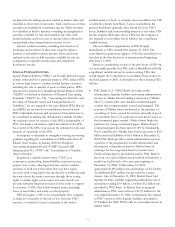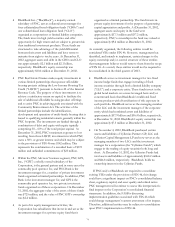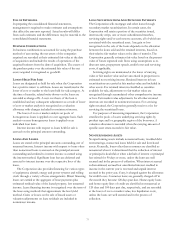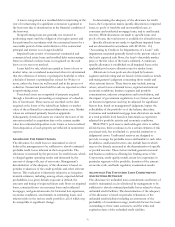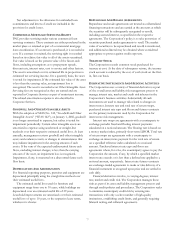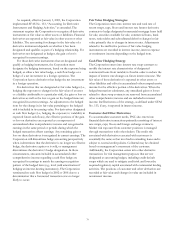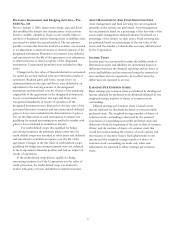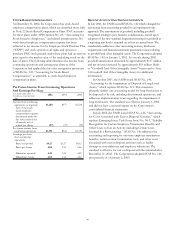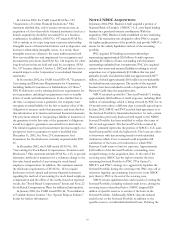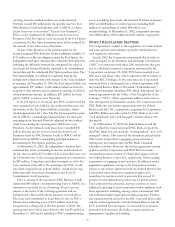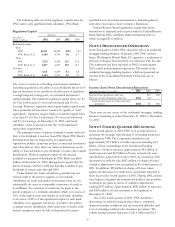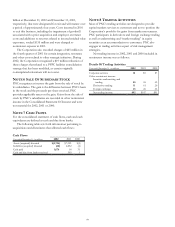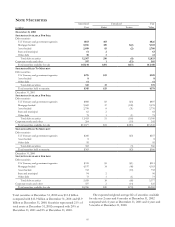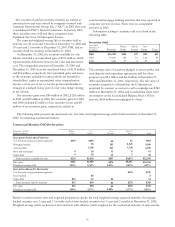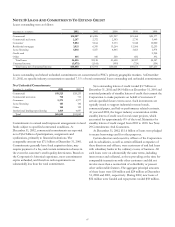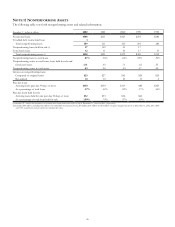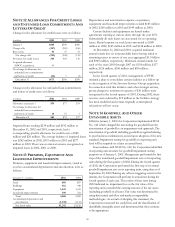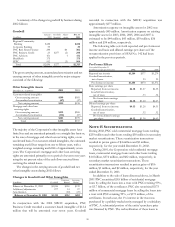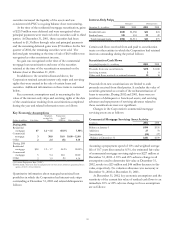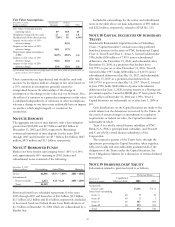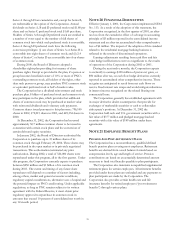PNC Bank 2002 Annual Report Download - page 85
Download and view the complete annual report
Please find page 85 of the 2002 PNC Bank annual report below. You can navigate through the pages in the report by either clicking on the pages listed below, or by using the keyword search tool below to find specific information within the annual report.
83
The following table sets forth regulatory capital ratios for
PNC and its only significant bank subsidiary, PNC Bank:
Regulatory Capital
Amount Ratios
December 31
Dollars in millions 2002 2001 2002 2001
Risk-based capital
Tier I
PNC $5,121 $4,599 8.8% 7.8%
PNC Bank, N.A. 5,160 4,704 9.8 8.7
Total
PNC 7,233 6,958 12.5 11.8
PNC Bank, N.A. 6,877 6,581 13.0 12.1
Leverage
PNC 5,121 4,599 8.1 6.8
PNC Bank, N.A. 5,160 4,704 9.0 7.6
The access to and cost of funding new business initiatives
including acquisitions, the ability to pay dividends, the level of
deposit insurance costs, and the level and nature of regulatory
oversight depend, in large part, on a financial institution’s
capital strength. The minimum regulatory capital ratios are 4%
for Tier I risk-based, 8% for total risk-based and 3% for
leverage. However, regulators may require higher capital levels
when particular circumstances warrant. To qualify as “well
capitalized,” regulators require banks to maintain capital ratios
of at least 6% for Tier I risk-based, 10% for total risk-based
and 5% for leverage. At December 31, 2002, each bank
subsidiary of the Corporation met the “well capitalized”
capital ratio requirements.
The principal source of parent company revenue and cash
flow is the dividends it receives from PNC Bank. PNC Bank’s
dividend level may be impacted by its capital needs,
supervisory policies, corporate policies, contractual restrictions
and other factors. Also, there are statutory limitations on the
ability of national banks to pay dividends or make other capital
distributions. Without regulatory approval, the amount
available for payment of dividends by PNC Bank was $460
million at December 31, 2002. Management expects that the
parent company will have sufficient liquidity available to pay
dividends at current rates through 2003.
Under federal law, bank subsidiaries generally may not
extend credit to the parent company or its nonbank
subsidiaries on terms and under circumstances that are not
substantially the same as comparable extensions of credit to
nonaffiliates. No extension of credit may be made to the
parent company or a nonbank subsidiary which is in excess of
10% of the capital stock and surplus of such bank subsidiary
or in excess of 20% of the capital and surplus of such bank
subsidiary as to aggregate extensions of credit to the parent
company and its subsidiaries. Such extensions of credit, with
limited exceptions, must be fully collateralized by certain
specified assets. In certain circumstances, federal regulatory
authorities may impose more restrictive limitations.
Federal Reserve Board regulations require depository
institutions to maintain cash reserves with the Federal Reserve
Bank. During 2002, subsidiary banks maintained reserves
which averaged $112 million.
NOTE 4 DISCONTINUED OPERATIONS
In the first quarter of 2001, PNC closed the sale of its residential
mortgage banking business. In January 2003, PNC and the
buyer, Washington Mutual Bank, FA, agreed to a settlement of
all issues in dispute between them in connection with the sale.
The settlement has been reported in PNC’s fourth quarter
2002 results in discontinued operations. The results of the
residential mortgage banking business, which are presented on
one line in the Consolidated Statement Of Income, are as
follows:
Income (Loss) From Discontinued Operations
Year ended December 31 - in millions 2002 2001 2000
Income from operations, after tax $15 $65
Net loss on sale of business, after tax $(16) (10)
Total income (loss) from discontinued
operations $(16) $5 $65
There were no net assets of the residential mortgage banking
business remaining at either December 31, 2002 or December
31, 2001.
NOTE 5 FOURTH QUARTER 2001 ACTIONS
In the fourth quarter of 2001, PNC took several actions to
accelerate the strategic repositioning of its lending businesses
that began in 1998. The Corporation decided to exit
approximately $7.9 billion of credit exposure including $3.1
billion of loan outstandings in the institutional lending
portfolios. Of these amounts, approximately $5.2 billion of
credit exposure and $2.9 billion of loans, respectively, were
transferred to loans held for sale in 2001. In connection with
the transfer to held for sale, $653 million of charge-offs and
valuation adjustments were recognized in the fourth quarter of
2001. In addition, $90 million in charge-offs were taken
against the allowance for credit losses specifically allocated to
these loans in the fourth quarter of 2001. During 2002, actions
were begun to liquidate the institutional held for sale portfolio
resulting in net gains in excess of valuation adjustments
totaling $147 million. Approximately $626 million of exposure
and $298 million of loans remained to be liquidated at
December 31, 2002.
Also in the fourth quarter of 2001, PNC decided to
discontinue its vehicle leasing business due to continued
depressed market conditions and the increased difficulty and
cost of obtaining residual value insurance protection. The
vehicle leasing business had assets of $1.4 billion and $1.9


